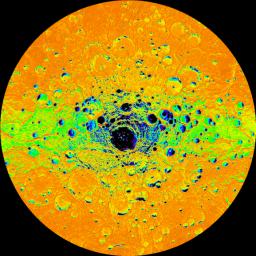
|
Illumination Map of Mercury’s South Pole
- Click the image above for a larger view
- Full-Res JPEG (1920 x 1920) (660.9 kB)
- Full-Res TIFF (1920 x 1920) (11.1 MB)
Caption:
Shown here is an illumination map of Mercury's south polar region. The map is colored on the basis of the percentage of time that a given area is sunlit; areas appearing black in the map are regions of permanent shadow. This map was created by using 89 wide-angle camera (WAC) images of Mercury's south polar region acquired by the Mercury Dual Imaging System (MDIS) over one complete Mercury solar day (176 Earth days) which can be viewed in this movie . Radar-bright deposits, which may be water ice, collocate with regions of permanent shadow .
Scale:
The large crater near Mercury's south pole,
Chao Meng-Fu
, has a diameter of 180 km
Map Information:
This illumination map is shown in polar stereographic projection, extending northward to 73° S, and 0° longitude is at the top
Background Info:
The MESSENGER spacecraft is the first ever to orbit the planet Mercury, and the spacecraft's seven scientific instruments and radio science investigation are unraveling the history and evolution of the Solar System's innermost planet. Visit the Why Mercury? section of this website to learn more about the key science questions that the MESSENGER mission is addressing. During the one-year primary mission, MDIS acquired 88,746 images and extensive other data sets. MESSENGER is now in a year-long extended mission, during which plans call for the acquisition of more than 80,000 additional images to support MESSENGER's science goals.
These images are from MESSENGER, a NASA Discovery mission to conduct the first orbital study of the innermost planet, Mercury. For information regarding the use of images, see the MESSENGER image use policy .
Cataloging Keywords:
| Name | Value | Additional Values |
|---|---|---|
| Target | Mercury | |
| System | ||
| Target Type | Planet | |
| Mission | MESSENGER | |
| Instrument Host | MESSENGER | |
| Host Type | Orbiter | |
| Instrument | Mercury Dual Imaging System (MDIS) | |
| Detector | Wide Angle Camera (WAC) | |
| Extra Keywords | Color, Crater, Map, Radar, Radio, Shadow, Water | |
| Acquisition Date | ||
| Release Date | 2012-03-21 | |
| Date in Caption | ||
| Image Credit | NASA/Johns Hopkins University Applied Physics Laboratory/Carnegie Institution of Washington/Byrne et al. | |
| Source | photojournal.jpl.nasa.gov/catalog/PIA15527 | |
| Identifier | PIA15527 | |
